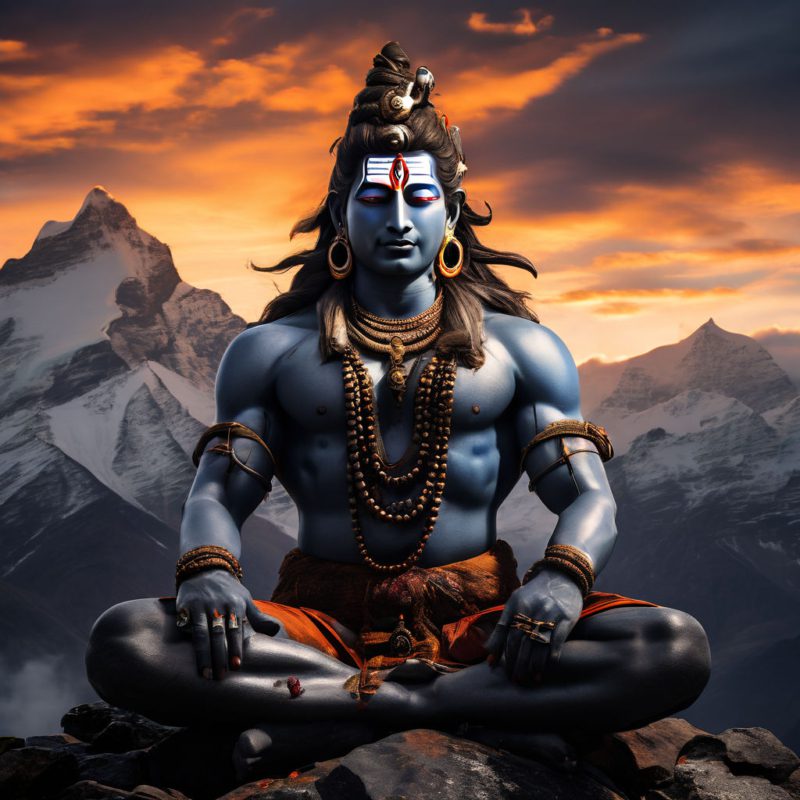Virupaksha is one of the names of Lord Shiva, one of the principal deities in Hinduism. The term “Virupaksha” can be translated to mean “One with Oblique Eyes” or “Having Wide Eyes.” In the context of Shiva, it emphasizes his all-encompassing vision and awareness.
Virupaksha is a special form of Lord Shiva, which is one of his many forms. In this form, Lord Shiva is worshiped in his visible form. “Virupaksha” means “without any contradiction” or “without any significance”. This form reflects His intangible, wonderful, and omnipresent nature and inspires the devotees to surrender to His wonderful divinity.
Virupaksha– ‘ओम रुद्राय रोगनाशय आगाचा चा राम ओम नमः’
‘Om Rudray Roganashaya Agacha Cha Ram Om Namah’
Table of Content
Avatar Info
Birupakshya, revered as the sacred deity of the Kirat people in Kathmandu, was erected by the ancient Kirati kings of Nepal, considered as an ancestor figure. Also known as Kirateswor Mahadev, this deity holds significance among the diverse Kirat community, with varying beliefs and deities.
In South India, Birupakshya is worshipped as Virupaksha. An idol of Virupaksha can be found to the east of the Pashupatinath Temple, situated on the right bank of the Bagmati River. Interestingly, half of Virupaksha’s body is positioned underground, with the other half above the ground. The statue is believed to be gradually emerging, and there is a belief that the world might face destruction if the entire statue were to emerge fully. Virupaksha is also referred to as Kali because it is believed that his complete emergence would mark the end of the Kali Yuga.
Before the Licchavi dynasty in Nepal, Virupaksha served as a naga chief. Additionally, he held the role of the patron deity for Shree Bhogini, the naga queen of Licchavi King Mandev.
Incarnation
Virupaksha, which is the fierce form of Shiva, according to Hindu scriptures, Shiva chose to incarnate in this form after the death of Mother Sati in Daksha Yagya. Sati’s death created a feeling of unique grief in him, due to which anger manifested itself in the form of invisible Virupaksha. Fire began to shine in his cruel, deadly eyes.
Virupaksha was the family deity of the first dynasty of Vijayanagara and was worshiped for peace, prosperity, and success in war. Prasanna Virupaksha, with a merciful and benevolent form, was also worshiped in the Vijayanagara Empire.
The most prominent temple dedicated to the Virupaksha form of Shiva is located in the city of Hampi in Karnataka, on the banks of the Tungabhadra River. Here, Virupaksha fast is observed by the devotees in the month of Push to get relief from diseases.
Place of Avatar
According to an ancient legend, Lord Shiva gifted a special Shivalinga to Ravana, which gave rise to an important religious site. This story narrates the occurrence of this inspiring event, which is considered unique in the history of Hinduism.
Ravana, the king of Lanka, aspired to become a devout devotee and resolved to obtain a boon from Lord Shiva. Lord Shiva was renowned for his penchant for intelligence and constant meditation, and seeing Ravana’s truth-seeking heart, he blessed him with a unique Shivalinga. Ravana placed this Shivalinga in the Panchavati area, where the Shivalinga is inclined towards the south.
According to ancient Puranas, when Ravana decided to take this Shivalinga to Lanka, an old man met him and caught hold of the Shivalinga. Ravana taught him piety and discipline, from which the old man attained salvation for his soul by meditating and worshiping Shiva.
Thus, that Shivalinga could not reach Lanka and stopped there, leading to the name of the place as “Virupaksha” or “Pampa Pathi”. This temple is still important for the devotees and crowds of devotees come there every year on religious occasions like Shivratri festival etc.
Purpose
In the manifestation of Virupaksha, Lord Shiva assumes the profound role of the eternal observer. Unlike other avatars that actively participate in the cosmic play, Virupaksha chooses the path of silent observation, highlighting Shiva’s omnipresence and omniscience. This unique aspect of Lord Shiva as Virupaksha signifies a transcendence beyond direct involvement in the cosmic dramas, emphasizing a detached yet all-encompassing awareness.
Virupaksha’s avatar embodies the divine quality of being a silent witness to the intricate dance of creation, preservation, and dissolution unfolding in the cosmic sphere. The name “Virupaksha” itself suggests the one with a formless or all-encompassing gaze, reinforcing the idea of a watchful deity who beholds the unfolding events without active interference.
As the eternal observer, Virupaksha symbolizes a serene detachment, highlighting the timeless and unchanging nature of Lord Shiva. This avatar showcases Shiva’s ability to perceive the grandeur of the universe without being entangled in its transient manifestations. It reinforces the understanding that Shiva’s consciousness pervades every corner of existence, serving as a silent witness to the ebb and flow of cosmic energies.
The significance of Virupaksha lies in its role as a reminder of Shiva’s omnipresence and omniscience, transcending the limitations of time and space. The silent observation of Virupaksha serves as a powerful metaphor for the yogic concept of detached awareness, encouraging seekers to cultivate a witness-like consciousness that remains undisturbed amidst the ever-changing panorama of life.
In essence, the Virupaksha avatar beautifully encapsulates the depth of Shiva’s cosmic role, portraying a deity who, while not directly participating in the cosmic play, symbolizes the eternal observer, embodying the unwavering consciousness that underlies the vast tapestry of existence.


